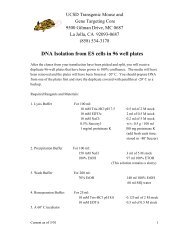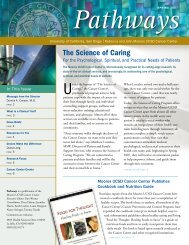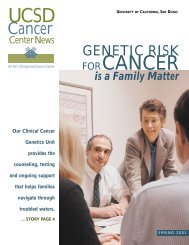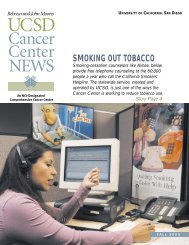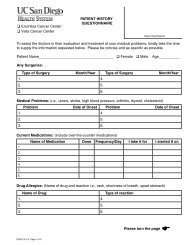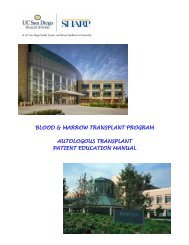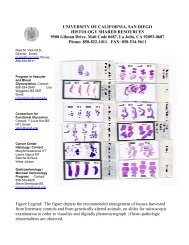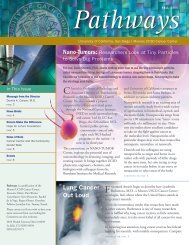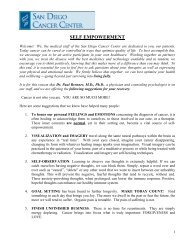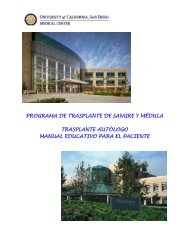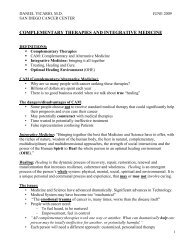Human Face - Moores Cancer Center
Human Face - Moores Cancer Center
Human Face - Moores Cancer Center
- No tags were found...
Create successful ePaper yourself
Turn your PDF publications into a flip-book with our unique Google optimized e-Paper software.
■ A national construction company hasbeen retained to provide pre-constructionservices, and discussions are now takingplace with them to provide general contractorservicesAs you can see, we are on an ambitiousschedule to bring this major, state-of-theartfacility to fruition within the next twoyears.Beyond creating new synergies within ourown <strong>Cancer</strong> <strong>Center</strong>, this building will providea platform for new collaborationswith other cancer organizations in SanDiego. You may haveheard of an effortunder way by 21 localcancer organizations tocreate a regional consortiumcalled the SanDiego Regional <strong>Cancer</strong>Institute, which wouldbe funded by tobaccosettlement monies. Theprivately funded UCSD<strong>Cancer</strong> <strong>Center</strong> buildingproject is separate fromthe consortium endeavor, but the <strong>Cancer</strong><strong>Center</strong> is fully supportive and an activeparticipant in it.In terms of scientific achievements,<strong>Cancer</strong> <strong>Center</strong> physicians and researchersare making tremendous strides in ourunderstanding of cancer and in its prevention,diagnosis and treatment. Forexample, <strong>Center</strong> members:■ have discovered a strong link between acommon human virus and colorectalcancer, which may be responsible for alarge percentage of non-hereditary coloncancer■ are studying a type of blood stem-celltransplant as a treatment for kidneycancer, which holds promise as animportant advance for patients withthis type of cancer“With this latestachievement we aremoving forwardenthusiastically withbuilding our visionof the cancer centerof the future.”■ have introduced a new procedure calledductal lavage that can detect pre-malignantand malignant breast cells longbefore they become visible tumors■ have developed an intriguing fluorescentmouse model of pancreatic cancerthat is already revealing important newinsights about this deadly disease■ have created a strong program in pharmacogenomics,an exciting new field thataims to tailor chemotherapy based on anindividual’s genetic profileWhile some of our accomplishmentsmake headlines, our coverstory topic rarely makesnews. Nonetheless, it isamong the most importantthings we do. I’m referringto the exceptional care providedby our oncologynurses. In this issue of the<strong>Cancer</strong> <strong>Center</strong> newsletterwe feature our chemotherapynurses; but we paytribute to all, whether theywork in the outpatient clinics, in theoperating rooms, or in the communityproviding home visits. Oncology nursesdeliver compassion, friendship andunderstanding along with their clinicalskills. It is these human qualities thatpatients remember long after the lastchemotherapy treatment. We’re proud ofour nurses and the special brand of careand caring they bring to patients, quietly,every day.If you see a nurse, thank her or him.They deserve our utmost respect andsupport.Sincerely,David Tarin, M.D., Ph.D.Director, UCSD <strong>Cancer</strong> <strong>Center</strong>IN THIS ISSUEThe <strong>Human</strong> <strong>Face</strong>of Chemotherapy4The <strong>Cancer</strong> <strong>Center</strong>’sNCI Designation6<strong>Cancer</strong> <strong>Center</strong> TestsNew Leukemia Drug8Luau and LongboardInvitational9Calendar of Events10John S. LyonsMemorial Foundation11Philanthropy NotebookBack Page3UCSD <strong>Cancer</strong> <strong>Center</strong> News
The<strong>Human</strong> <strong>Face</strong>ofChemotherapyNurses Provide Comfortin the StormBy Sarah LiftonChemotherapy nurse Judy BoomerOn the days when she’sscheduled to receivechemotherapy at theUCSD <strong>Cancer</strong> <strong>Center</strong>’s Perlmanclinic, Josefina Martinez will oftenget up early and prepare carneasada or soup for all the nursesshe’ll encounter that day. Otherpatients may present cookies,flowers, cards or other small gifts.Still others may convey their regardsimply through words, eye contactand body language.These expressions of gratitude,however diverse, reflect the centralrole that chemotherapy nurses playin their patients’ lives, helping themweather an especially difficult timewith skill, compassion and goodhumor.“The appreciation is absolutelyincredible,” said nurse Judy Boomer,who works in the Perlman chemotherapyroom. “Patients give back so muchmore than we’re able to give.”Patients, however, see things a littledifferently.“I can’t envision a more stressfuljob, especially because the nurses areso personally involved,” said C.J.Carroll, a chemotherapy patient. “It’shard to imagine how anyone can giveso much.”By any measure, chemotherapynursing is a challenging profession,requiring the physical stamina tospend grueling hours on one’s feet,the organizational skills to managenumerous patients receiving treatmentslasting from one to 10 hours,a high degree of technical expertise(and special certification) to administermany potent drugs, and theempathy and humanunderstanding to addresspsychosocial issues andfamily dynamics.“There are times,” saidCarol Horton, achemotherapy nurse at the<strong>Cancer</strong> <strong>Center</strong>’s clinic inHillcrest, “when patientshave told me that I need tobe sitting in the chemochair and they should betaking care of me.”Attending to Many DetailsWhile chemo nurses’ primary workconsists of scheduling and monitoringthe treatments of multiplepatients, all of whom may be in differentstages of diverse therapies, in agiven 10-hour shift they will also findthemselves drawing blood and followingup on lab work; counselingpatients; coordinating care withphysicians; and troubleshooting thesymptoms of patients at risk of complications.They will give injections ofdrugs for supportive care, such asEpogen to stimulate red blood-cellproduction and Neupogen to promotewhite blood-cell production.They will consult with staff pharmaciststo help clarify or adjust patients’medication schedules. And they alsoset the tone in the chemo room.“We try to keep things as light aswe can, and we encourage people totalk with one another,” said Boomer.“It’s comforting for patients to be in aplace where there are skilled, knowledgeableprofessionals,and where patients areable to talk to otherpatients experiencingthe same circumstances.It’s especiallyrewarding to have apatient not be frightenedafter the firstvisit.”All this makes for atricky balancing act asnurses strive to remainPatient Josefina MartinezUCSD <strong>Cancer</strong> <strong>Center</strong> News4
focused on delivering outstanding medicalcare and simultaneously maintaintheir human touch. For those with therare combination of skills and compassion,however, working as a chemotherapynurse can be an extraordinarilyrewarding experience. Advances in treatmentmean that cancer now is often achronic condition to be managed, somewhatlike diabetes or heart disease. As aresult, the nurses who work with cancerpatients get to know them well.“<strong>Cancer</strong> patients make an impact onyour life that’s unlike the experience inany other specialty," said Boomer. "Yousee them for so long and are able tohelp them through a difficult andextended period. You get to know themon a personal level, and become part oftheir family. It’s wonderful to be a partof that.”The relationship with patients can beat once the most fulfilling and difficultaspect of the job, especially when anurse grows close to someone wholoses the battle against the disease.Although it can be hard to distancethemselves from their patients, nursesmust learn early on to cope with thedisappointments.“It’s easy to give too much of yourself,but you can’t give it all away,” saidBoomer. “To be effective you have tokeep some in reserve for yourself. Youhave to learn how to deal with that.”Focusing On the PositiveJoy Sutera, a nurse in the Perlmanclinic, tries to focus on the ways inwhich she has made a difference inher patients’ lives, regardless of theoutcome.“This is a difficult journey, and it’shard to watch people go through it, butI’ve been able to learn some skills thatmake it easier. I may come in one dayand learn that someone has just passedaway and it saddens me. But then I maystart with someone new who respondswell. The treatments do work or Iwouldn’t be doing this, and a numberof people do very well. We can still helpthe ones we aren’t able to cure. We’rehere to do all that we can.”Counterbalancing the losses are themany cancer success stories. Sutera isstill close to a patient of hers from 25years ago, a girl who at the time wasgiven a 5 percent chance of surviving.The patient, now a young mother, hashad no recurrence of cancer and recentlyattended Sutera’s birthday party.Horton recalls treating a young manwith lymphoma of the eye.“His left eye was the size of a fist, andhe couldn’t open it,” she said. “We gavehim treatment four days in a row. Onthe fourth day, the tumor had gonedown so much that you could see thewhite of his eye. When he came in onMonday to have blood drawn, his eyewas nearly back to normal, he had hisglasses on, and he looked as if he justhad a little swelling under the lid. WhenI see something that dramatic, I knowI’ve done the right thing, and chemo isthe answer.”Although they deal daily with lifeand death, the nurses are sometimessurprised by the depth of theirpatients’ feelings for them. Sutera tellsof one woman who presented her withan arrangement of business cards offamous women and included Sutera’s,saying that she was among the world’sgreat women because she had madesuch a difference in the woman’s life.“You don’t always realize how muchof a difference you can make until apatient does something special foryou,” said Sutera. “It’s always surprisingto realize that something I did hadthat kind of an impact because, well,I’m just doing my job.”Sarah Lifton is a freelance writer whospecializes in health care and highereducation topics.ONCOLOGYNURSING:A Brief IntroductionThe field of oncology relies onthe skills of nurses in severaldifferent subspecialties.In addition to chemotherapynursing (see article, page 4),the UCSD <strong>Cancer</strong> <strong>Center</strong>employs nurses as case managerswho work with physiciansto coordinate all aspectsof patients’ treatments, fromphysician visits to insuranceauthorization to paperworkfor labs and getting prescriptionsto the right pharmacies.Case managers also workclosely with patients andserve as doctors’ eyes andears on the front lines, makingthem aware of any abnormalitiesand ensuring thatnothing slips through thecracks.Surgical oncology nursesdon’t scrub in to the operatingroom, but see patients inthe office and provide pre-opeducation and post-op followup. Radiation oncology nurses,who usually see patientsfive days a week for four tosix weeks, assist with variousaspects of radiation therapy,assessing patients, gettingthem set up for treatmentand generally running interferencewith physicians.According to their colleagues,the common thread amongall oncology nurses, regardlessof their area of expertise, is ahigh level of innate compassionand understanding.5UCSD <strong>Cancer</strong> <strong>Center</strong> News
Latest Milestone Heightens<strong>Cancer</strong> <strong>Center</strong>’s StandingMore than 2,500 U.S. hospitals and medical centersprovide cancer care, but only 51 — or 2 percent— have earned a designation by the National <strong>Cancer</strong>Institute (NCI) for research and clinical care.For 22 years the UCSD <strong>Cancer</strong><strong>Center</strong> has held that special mark ofdistinction, and now its standinghas been substantially enhancedwith a five-year, $19 million supportgrant from the NCI. This award, atripling of the funding provided inthe past, accompanies the renewalof the center’s NCI designation forthe maximum period possible.The grant of financial support andthe renewal of the NCI designationwere the culmination of a rigorousreview by the nation’s highest cancerorganization, which recognized theenormous strides the <strong>Cancer</strong> <strong>Center</strong>has made over the past few yearsand cast a vote of confidence in thecenter’s plans to advance to the nextlevel of excellence.“It is tremendously gratifying tohave earned this level of recognitionfor our efforts to enhance programs,services and facilities for the benefitof our community,” said DavidTarin, M.D., Ph.D., director ofUCSD <strong>Cancer</strong> <strong>Center</strong>. “The NCIgrant and UCSD’s institutional supportof the <strong>Center</strong>, along with thegenerosity of individuals, are making“The NCI grant and UCSD’s institutional support ofthe <strong>Center</strong>, along with the generosity of individuals, aremaking it possible for San Diego to have the world-classcenter this community deserves.”— <strong>Center</strong> Director David Tarinit possible for San Diego to have theworld-class center this communitydeserves.”The grant provides funds to coverthe costs of administering the centerand operating its 12 core facilities,called shared resources. These facilitiesprovide sophisticated technicalservices such as data compilationand analysis, digital imaging, DNAsequencing and flow cytometry toresearchers throughout the <strong>Center</strong>. Italso ensures the <strong>Center</strong> a stablefoundation upon which to developinnovative new research projects.However, the significance of thegrant extends far beyond the financialarena, according to IraGoodman, the <strong>Center</strong>’s AssociateDirector for Administration.“The <strong>Cancer</strong> <strong>Center</strong>’s NCI designationrepresents benefits for theentire region,” he said. “As part ofthe network of America’s most outstandingcancer centers, we are bothcontributors to and beneficiaries ofthe most advanced body of knowledgeabout cancer. As the only federallydesignated provider of clinicalcancer care in San Diego andImperial counties, we are uniquelypositioned to bring the latest developmentsin cancer prevention, diagnosisand care to the people of theregion, based upon research beingconducted nationwide as well ashere in the center.”UCSD <strong>Cancer</strong> <strong>Center</strong> News6
Community SupportMakes a DifferenceThe benefits of the <strong>Cancer</strong> <strong>Center</strong>to the local community and itsnational reputation for conductinghigh quality research are among theprincipal reasons behind the highlevel of community support that itsmost ambitious project — the campaignfor a new <strong>Cancer</strong> <strong>Center</strong>building — has enjoyed.Last year, John <strong>Moores</strong>, majorityowner of San Diego Padres andRegent of the University ofCalifornia, and his wife, Rebecca,made a $20 million commitment tothe project, one of the largest giftsfrom private individuals everreceived by UCSD.The project has also received $15million from longtime supportersand UCSD volunteers Jerome andMiriam Katzin, as well as gifts inexcess of $1 million from UCPresident and former UCSDChancellor Richard C. Atkinson,and his wife, Rita; William andRobin Comer, Frank and LeeGoldberg, Maurice and CharmaineKaplan, and Ron and Mary Taylor.“This support confirms the centralrole that the UCSD <strong>Cancer</strong><strong>Center</strong> plays in cancer research, careand education,” said PeterAnderson, Director of Developmentfor the <strong>Cancer</strong> <strong>Center</strong> Foundation.“Intensive efforts are continuing tosecure the remaining funds neededto complete the new building.”Future home of the UCSD <strong>Cancer</strong> <strong>Center</strong>A Distinctive Track RecordThe success of the project to dateis also a reflection of the <strong>Center</strong>’soutstanding track record. Among itsmore than 200 clinicians andresearchers are seven members ofthe National Academy of Sciencesand one Nobel laureate. One memberranks first in the world in thenumber of high-impact researchpapers he wrote that were quoted byothers in professional journals.Members of the <strong>Cancer</strong> Preventionand Control Program are knowninternationally as the group thatexposed the role that tobacco advertisingplays in encouraging adolescentsto smoke.Members’ work — which rangesfrom fundamental cancer researchin molecular genetics to the mostadvanced treatments, from drugdiscovery to pain and symptomcontrol, and from population studiesof cancer incidence to communityeducation on prevention andearly detection — includes a numberof highly competitive programgrants. The center is also takingpart in more than 200 clinicaltrials, and its programs in cancerprevention and epidemiology areconsidered to be among the bestin the nation.UCSD ranks among the top 30grantees of the NCI in terms oftotal funding, even without factoringin the latest multimillion-dollaraward.Furthermore, as cancer investigatorswithin a much larger academicenvironment, <strong>Center</strong> membershave direct access to their universitycolleagues in many otherspecialties and disciplines, creatingan intellectual and scientific crossfertilizationwith the potential tosignificantly advance their efforts.“We are now positioned to fullyfocus on building our vision ofthe cancer center of the future,”said Tarin.7UCSD <strong>Cancer</strong> <strong>Center</strong> News
<strong>Cancer</strong> <strong>Center</strong> involved inTesting New Leukemia Drug ‘Gleevec’The U.S. Food and DrugAdministration recentlyannounced its approval of theoral drug Gleevec for chronic myelogenousleukemia (CML), which showedstunning results in clinical trials. UCSD<strong>Cancer</strong> <strong>Center</strong> was one of the sites forclinical testing of the drug.“As participants in the nationalstudy, we were pleased to have beenable to offer this important option toour patients,” said <strong>Cancer</strong> <strong>Center</strong>member Asad Bashey, M.D., Ph.D.,who was the principal investigator forthe UCSD study site.Each year approximately 4,500Americans are diagnosed withCML, a disease in which toomany white blood cells aremade in the bone marrow, thespongy tissue inside the largebones in the body.“Gleevec targets a specific moleculethat is only found on CML cells, so it isable to kill the cancer cells with little orno damage to normal cells,” saidBashey. “This represents a tremendousadvance in cancer chemotherapy.”With the recentexplosion of powerfulmolecular technologynow available in cancerresearch, scientists aresearching intensively to discovertargets in other cancers. AtUCSD, for example, researchers areprobing the anatomy of prostatecancer cells in search of molecules thatare unique to that cancer. If such moleculesare found, these could pave theway for development of future molecular-targeteddrugs, similar to Gleevec.Outreachcrosses state linesResearchers in the <strong>Cancer</strong> <strong>Center</strong>’s CommunityOutreach and Education Program, in conjunction withDeaf Community Services and the UCSD Departmentof Communications, have developed a cancer educationprogram designed to reach members of the Deaf community.This innovative program has generated interest throughoutCalifornia, and now in five states in the Midwest.During a videoconference in the <strong>Cancer</strong> <strong>Center</strong>’s conferencingfacility, interpreter Janet Maxwell (right) of the UCSDDepartment of Communications signs for project coordinatorDarline Gunsaul (left), as the <strong>Cancer</strong> <strong>Center</strong>’s Georgia RobinsSadler, Ph.D., shares details of the Deaf Community <strong>Cancer</strong>Education Program with interested cancer educators. Theeducators — who want to replicate the program for Illinois,Kansas, Missouri, Nebraska and Oklahoma — represent theAmerican <strong>Cancer</strong> Society, the National <strong>Cancer</strong> Institute’s<strong>Cancer</strong> Information Service, and the Deaf community.The program has been produced on videotape and distributedstatewide by the California Department of HealthServices. It can also be viewed on the <strong>Cancer</strong> <strong>Center</strong>’s website: http://cancer.ucsd.edu/outreach/Deafinfo/index.htm.Beauty of DanceSupports Pancreatic <strong>Cancer</strong>Dance aficionados gathered at theLawrence Community Theatre in LaJolla recently for a gala evening of balletto raise funds for pancreatic cancer research atUCSD <strong>Cancer</strong> <strong>Center</strong>. The benefit was dedicatedto the memory of Dame Sonia Arova, whoseinternational renown as a prima ballerina wascomplemented by many years in San Diego as apre-eminent teacher of dance.The program brought together former studentsof Dame Sonia from ballet companies throughoutCalifornia and from as far away as Alabama.Among the dances performed were timeless selectionsfrom “Sleeping Beauty” and “Swan Lake,”along with more contemporary works and anoriginal pas de deux choreographed in lovingmemory by Thor Sutowski, husband of the lateDame Sonia.<strong>Cancer</strong> <strong>Center</strong> Director David Tarin commented,“It is an honor for our <strong>Cancer</strong> <strong>Center</strong> to beselected as a beneficiary of this creative responseto the need for new research into pancreatic cancer.We are grateful to have the beauty of danceplaced in service to that important cause.”Sponsors for the event were the San DiegoDance Alliance, the Pacific Repertory Ballet, andMr. Sutowski. Volunteer organizers includedBarbara Gibson, Director of the Pacific RepertoryBallet, and her sister, Chris Gibson, NurseManager of UCSD Radiation Oncology.UCSD <strong>Cancer</strong> <strong>Center</strong> News8
Surf event rides waveof success for cancerThe 8th Annual UCSD <strong>Cancer</strong> <strong>Center</strong> Luau & LongboardInvitational will be held on Sunday, August 26, at theScripps Institution of Oceanography in La Jolla.Surf art pioneer John Severson has created this piece'Legends of La Jolla' as the official artwork of the EighthAnnual Luau. The piece will be auctioned off during theLuau portion of the event with the proceeds going tofund research at the <strong>Cancer</strong> <strong>Center</strong>.Last year the event raised$200,000. Organizers ofthis year’s event hope totop this amount with the helpof local businesses, celebritiesand the surfing legends of the‘50s and ‘60s.For the second year in arow, Ericsson has signed on asthe Title Sponsor of the event,which raises money to fundpromising new cancerresearch programs. Othersponsors include SilvergateBank (VIP), ChugaiPharmaceuticals (VIP),Cymer (VIP), Pacifica Trust,Scripps Institution ofOceanography, DPR SanFrancisco, DPR San Diego, The Genomics Institute,Qualcomm and Yahoo.Hawaiian Airlines has agreed to be the Official Airlines ofthe 2001 event. As part of their sponsorship they willdonate the “Ultimate Hawaiian Getaway,” which will be featuredduring the live auction portion of the event. Thispackage includes two first-class roundtrip tickets from SanDiego to Oahu, an inter-island flight pass good for travelbetween the islands, as well as seven nights hotel accommodationson the winner’s choiceof island and a seven day carrental.The event includes an earlymorning surf competition ofteams sponsored by local companies,and a sumptuous luau-stylebuffet with Polynesian dancers.A highlight of the day’s activitieswill be the mid-morning“Expression Session,” whenapproximately 30 surfing legendswill take to the water for a specialexhibition of their incomparabletechniques.“This is a unique and funevent. What other local fundraiserallows you to wear shorts and aHawaiian shirt, takes place outdoorsat the water’s edge and mixes Fortune 500 executives,local and national celebrities, and the legends of surfing?We really are ‘surfing for a cure’ and I can’t think of a moreimportant cause,” said event chair Steve Blank.The UCSD <strong>Cancer</strong> <strong>Center</strong> Luau & LongboardInvitational has raised nearly $900,000 over the last sevenyears. To find out how you can get involved, visitwww.luau.ucsd.edu, or contact Steve Blank at(858) 822-2293 or stblank@ucsd.edu.9th Annual Moeller Run/Walk Supports Melanoma ResearchOn a recent spring day,approximately 80 SymitarSystems employees andtheir families put on their walkingshoes and joined in the 9th AnnualMurray Moeller Run and Walk. Theenthusiasm level was high as runnersand walkers traversed 3.1 scenicmiles of the UCSD campus. Afterthe run/walk, participants gatheredat Humphrey’s on the Bay for acompany-hosted, scrumptiousbrunch and award ceremony.Coordinated by TheresaBenavidez, this annual event is heldin memory of Murray Moeller, aSymitar employee who died ofmelanoma in 1992. Mr. Moeller’sparents were on hand to cheer onthe runners and walkers as theycrossed the finish line. The SymitarSystems board of directors matchesfunds raised by employees for thismemorial. To date, this run/walk hascontributed over $25,000 to theUCSD <strong>Cancer</strong> <strong>Center</strong> for melanomaresearch.9UCSD <strong>Cancer</strong> <strong>Center</strong> News
Do the Lopiccola!AFishing for a Good Time?vid anglers will once againflock to Cabo San Lucasthis autumn to raisefunds for cancer research by participatingin the 14th Annual “ForPete’s Sake” Pete LopiccolaMemorial Marlin Tournament.The dates for this year’s tournamentare October 18-20.Join the fun as tournamentparticipants Fish for a Cure on thebeautiful blue waters of the PacificOcean that surround the southernmosttip of the Baja Californiapeninsula. Then relax and enjoy afestive awards banquet and live auctionon Saturday evening. Onceagain, tournament headquarterswill be at the picturesque HaciendaBeach Resort.Tournament organizersare pleased to announcethat, for the first time, thetournament involves 100percent release of allbillfish.The “For Pete’s Sake” MarlinTournament is the largest and mostsuccessful charity sport fishingtournament on the West Coast.All proceeds go to support researchat the UCSD <strong>Cancer</strong> <strong>Center</strong> and tohelp medically needy children inthe Cabo area. Last year’s tournamentcontributed $136,000 to supportcancer research, the largestamount ever raised in a single year.Terri Brodeau, this year’sTournament President, andLopiccola Foundation ChairmanChuck Faith noted that the eventhas raised nearly $900,000 for cancerresearch over the last 11 years,and this year the committee’s goal isto break the million-dollar mark.For further information, pleasecontact Cheryl Coate at the UCSD<strong>Cancer</strong> <strong>Center</strong> Foundation at(858) 822-0023 or the For Pete’sSake hotline a (619) 475-4636, orvisit the “For Pete’s Sake” website atwww.petesake.com.SPECIAL EVENTS CALENDARAUGUST 26, 20018th Annual Luau & LongboardInvitationalScripps Institution of Oceanography,La Jolla; 7:00 a.m. - 5:00 p.m.Contact Steve Blank, (858) 822-2293or visit: www.luau.ucsd.eduOCTOBER 18-20, 200114th Annual Pete LopiccolaMemorial Marlin TournamentCabo San Lucas, Baja California, MexicoCall (858) 822-0023 or the ”For Pete'sSake” hotline at (619) 475-4636or visit www.petesake.comOCTOBER 18-21, 2001Saks Fifth Avenue “FashionTargets Breast <strong>Cancer</strong>”Saks Fifth Avenue stores in FashionValley Mall and downtown La JollaCall (858) 822-0023MAY 18, 200221st Annual Celebrities Cookfor the UCSD <strong>Cancer</strong> <strong>Center</strong>Sheraton San Diego Hotel and MarinaCall (858) 822-0023SAKS Targets Breast <strong>Cancer</strong>with special eventsFor the third consecutive year,the UCSD <strong>Cancer</strong> <strong>Center</strong>and Saks Fifth Avenue are teamingup in the fight against breast cancer.As part of Saks’ nationwidecampaign, called “Fashion TargetsBreast <strong>Cancer</strong>,” the San Diego Saksstores will offer several specialevents from October 18 to 21, andwill donate a percentage of salesmade during the promotion to thebreast cancer research program atUCSD <strong>Cancer</strong> <strong>Center</strong>. The goal forthis year’s event is to raise$400,000 to advance the researchand treatment of breast cancer.The events planned throughoutthe four days include a “San Diegoby the Bite” reception on Thursdayevening, October 18, at theFashion Valley store; a luncheonand fashion show on Friday,October 19, at the downtownLa Jolla store; alight brunchand fashionshow onSaturday,October 20,at the FashionValley store; plus numerous trunkshows, makeovers and specialoffers throughout the weekend atboth locations.Co-chairs Lee Goldberg andJeanne Jones are delighted toannounce that for the second yearWindstar Cruises will donate aone-week cruise for two for thelucky winner of a fabulousOpportunity Drawing.For additional informationabout the “Fashion Targets Breast<strong>Cancer</strong>” events, contact CherylCoate at the UCSD <strong>Cancer</strong> <strong>Center</strong>Foundation office at (858) 822-0023.UCSD <strong>Cancer</strong> <strong>Center</strong> News10
I NIM EMORIAM:Bruce Hazard and Ben Keltst is with heartfelt sympathy that theUCSD <strong>Cancer</strong> <strong>Center</strong> pays tribute to thememory of two recently deceased volunteerleaders, Board member Bruce R. Hazardand Board member emeritus Ben D. Kelts.Mr. Hazard was a native of San Diegowho rose to prominence as a 66-year veteranof the regional construction industry.He served as President of the R.E. HazardContracting Company, a family enterprisethat he grew from a small grading companyinto a leader in freeway constructionand real estate development. A crowningachievement of his professional career wasthe opening in 1990 of Hazard <strong>Center</strong>, amixed-use commercial development inMission Valley. Survivors include his wife,Mary, of San Diego.Mr. Kelts was born in Eastern Europeand came to the United States at age 6.He went on to achieve great success as aventure capitalist who pioneered heavyequipmentleasing. UCSD <strong>Cancer</strong> <strong>Center</strong>became prominent among the several causesthat Mr. Kelts generously supportedupon moving to the San Diego area in thelate 1960s. An outgrowth of his volunteerservice as a Board member was his establishmentof a significant charitable remaindertrust to support programmatic prioritieswithin the <strong>Cancer</strong> <strong>Center</strong>. Survivorsinclude his wife, Sheri Lynne, of La Jolla.Frank M. Goldberg, <strong>Cancer</strong> <strong>Center</strong>Foundation Board President, said, “Thegenerosity of Bruce Hazard and Ben Keltsenabled the UCSD <strong>Cancer</strong> <strong>Center</strong> to reachhigh in its aspirations and plan boldly forthe future. Their record of philanthropy ispart of the lasting legacy that they leave forthe betterment of others.”MAKE A GIFTON-LINEThe UCSD<strong>Cancer</strong> <strong>Center</strong>Foundation now hasan even easier way to give.Through a secured serveryou can now make anon-line gift to the <strong>Cancer</strong><strong>Center</strong> by using a creditcard. Or, if you prefer, youcan print a gift form to maildirectly to the <strong>Cancer</strong><strong>Center</strong> Foundation office,along with your check orcredit card information.Either way, all the informationyou need is right atyour fingertips.To make a gift, visit ourwebsite athttp://cancer.ucsd.eduand click on the GIVINGsection.Lyons Foundation helps <strong>Center</strong> keep current with technologyThe John S. Lyons MemorialFoundation and “The Johns,”are the philanthropic arm ofthe San Diego County Building andConstruction Trades Council. Mr.Lyons was a leader in the TeamstersLocal 36, and gave 35 years of his lifeto Union work. He was an ardentcommunity leader who served on theboards of many state and local civicorganizations and non-profit agencies.Thanks to the dedication of ArtLujan, a <strong>Cancer</strong> <strong>Center</strong> FoundationAdvisory Board Member, and TradesCouncil Business Manager XemaJacobson, The Johns and theFoundation have contributed nearly$150,000 to UCSD <strong>Cancer</strong> <strong>Center</strong> since1996, and have stimulated matchingcontributions from other sources.This year’s $50,000 donation wasapplied toward the purchase of muchneeded laboratory equipment — anautomated immunohistochemistrystaininginstrument. This instrument,used by numerous <strong>Cancer</strong><strong>Center</strong> laboratories,processes tissuesamples and can beprogrammed to domultiple tasks, saving time for laboratorystaff and researchers who usethe results to compare normal tissueto cancer tissue.At a June 15 luncheon and checkpresentation, <strong>Cancer</strong> <strong>Center</strong> DirectorDavid Tarin paid tribute to The Johnsfor their outstanding service, saying:“The field of cancer research is constantlyand swiftly evolving. We areindebted to the ongoing generosityof The John S. Lyons Foundation andThe Johns for making critical financialresources available to the <strong>Cancer</strong><strong>Center</strong> to acquire the latest technology,enabling us to keep pace with therapid rate of progress.”During a recent luncheon, <strong>Center</strong> Director David Tarin (standing,third from left) accepted a check on behalf of the <strong>Cancer</strong> <strong>Center</strong>from the John S. Lyons Foundation. Also pictured: (seated,from left) Mac Colmenero, Xema Jacobson, Mike Magallenes;(standing, from left) Al Ludecke, Steve Chadwick, Emo Coleman,Phil Saal and John Young.11UCSD <strong>Cancer</strong> <strong>Center</strong> News
PHILANTHROPY NOTEBOOKThe UCSD <strong>Cancer</strong> <strong>Center</strong> Foundation is available to help youmake the most of your philanthropic giving. To this end, we arepleased to provide you with another edition of PhilanthropyNotebook, on the topic of charitable gift annuities.LEAVING A LEGACYThrough a Charitable Gift AnnuityMany charitably inclined individualshave wanted to domore to support the <strong>Cancer</strong> <strong>Center</strong>’sbasic mission of translating promisingscientific discoveries into new andbetter options for the prevention,diagnosis and treatment of cancer.Some have done this by establishing acharitable gift annuity to benefit theUCSD <strong>Cancer</strong> <strong>Center</strong>.How it works: Essentially thecharitable gift annuity is a combinationof a gift and a contract betweenthe donor and a charitable organization.In exchange for a contribution ofcash or marketable securities, thecharity guarantees to pay the incomebeneficiary or beneficiaries a fixedpayment for life. At the end of thepayment recipient’s lifetime, theremainder value of the gift annuitywill pass to the <strong>Cancer</strong> <strong>Center</strong>.The annuity amount paid to thedonor is based on the age of thedonor and the current payment rateestablished by the American Councilon Gift Annuities. For example, a75-year-old person who donates$10,000 to the <strong>Cancer</strong> <strong>Center</strong> wouldreceive $790 every year from theannuity, or 7.9 percent of the giftamount. An individual who is 85years old and makes the same gift,would receive an annual payout of$1,040, or 10.4 percent.It is reliable: Lifetime paymentsare fixed and guaranteed by the charitableorganization and represent asteady source of income.It offers additional taxbenefits: In addition to theincome benefits, a portion of thefixed annual payment will be consideredtax-free return and the donorwill be eligible to claim an immediatecharitable income tax deduction inthe year the gift is made. There alsomay be some capital gains tax savings,depending on the cost basis of theasset contributed.Leaving a legacy to the<strong>Cancer</strong> <strong>Center</strong>: Finally, a legacygift to support the UCSD <strong>Cancer</strong><strong>Center</strong> can bring satisfaction in helpingto touch countless lives for yearsto come through San Diego’s onlyNational <strong>Cancer</strong> Institute designatedclinical cancer center.For further information about charitablegift annuities and how they canfulfill your financial and charitablegoals, contact Geoff Graham,Associate Director of Development,at (858) 822-0024 orgcgraham@ucsd.edu.This article is not intended to offerlegal or tax advice. Specific circumstancesmay vary and services of anattorney and/or professional advisorshould be obtained.UCSD <strong>Cancer</strong> <strong>Center</strong>9500 Gilman Drive MC 0658La Jolla, CA 92093-0658(858) 822-0022Non-Profit Org.U.S. PostagePAIDSan Diego, CAPermit #1909




